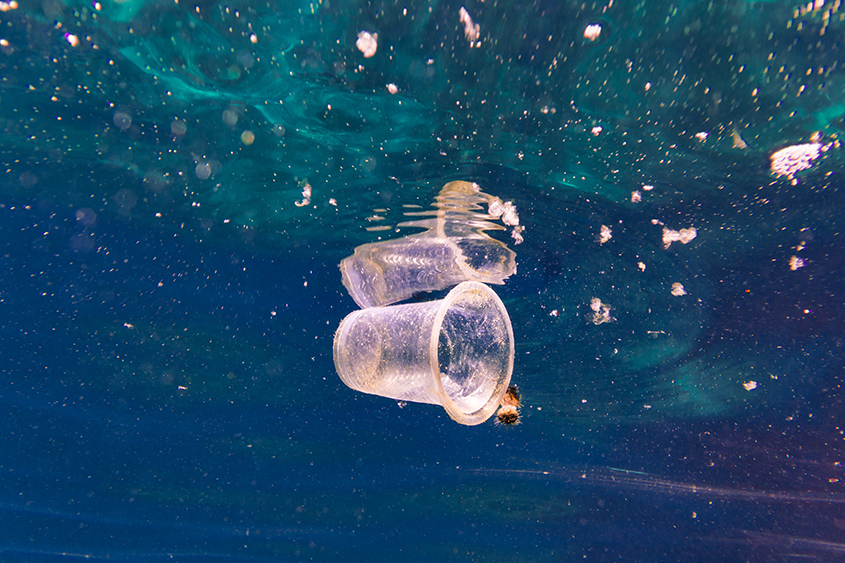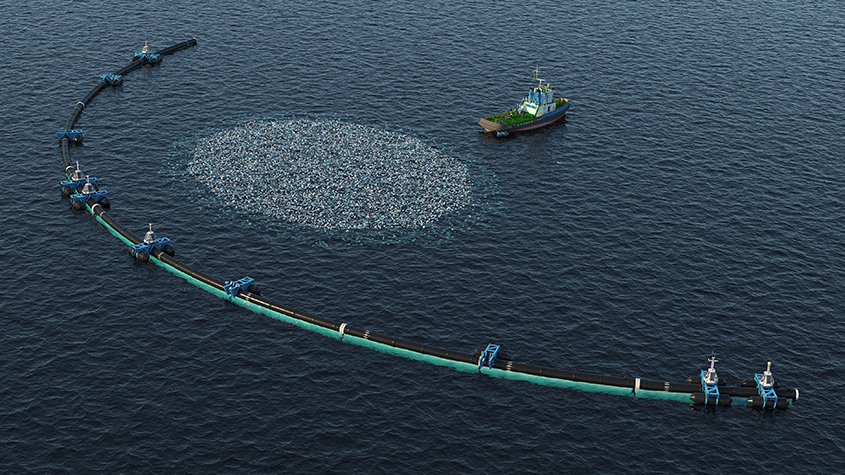

June 25, 2021
Around 70 percent of our planet is covered with water, and over 95 percent of that water is in oceans. In this feature, WIPO GREEN explores the challenges faced in addressing global ocean pollution and shares examples of green technologies that the world can use to make its water cleaner.

Blast from the past: a plastic bag from the fast-food chain KFC from the 1970s was found in the ocean almost 50 years later, in 2019. The United Nations Environment Programme (UNEP) estimates that by 2050 the ocean may contain more plastic waste than fish. Today, the challenge of ocean pollution is common knowledge, but not many understand the extent of the problem, and what can and should be done to address it.
Ocean waters today contain toxic metals, plastics, manufactured chemicals, petroleum, urban and industrial wastes, pesticides, fertilizers, pharmaceutical chemicals, agricultural runoff, and sewage, coming not only from direct dumping, but also from rivers and even the air through precipitation. Most of these materials are dangerous for both the underwater life (more than 800 species of marine life have been harmed by debris) and humans, with some of the pollutants being linked to causing problems with brain development in infants and to an increased risk of cardiovascular disease, dementia and cancer in adults.
Environmentally friendly method of removing oil from water
PROvendis GmbH, 2021
Scientists at the University of Bonn have developed a new method of cleaning water surfaces contaminated with oil. Textiles with special surface properties passively skim off the oil from the water’s surface and transport it into a floating container provided for this purpose. The textile has a superhydrophobic (water repellent) surface of hairs or grids, comparable to the surface of Salvinia plant.
Intelligence System to Collect Oil Spills
The First Institute of Canadian Inventors, 2016
The First Institute of Canadian Inventors, 2016 This fully automatic device to collect oil spills from water surfaces can be dropped to the ocean from oil ship tankers or helicopters in case of an accident. The technology is light, portable and fully independent from human control, with equal efficiency during the day and night. It uses nano filters to separate oil from water, collecting the oil in containers and releasing the treated water into the ocean.
The way we understand marine pollution is not always accurate; for example, one may think that big oil spills are one of the main contributors to the pollution because of predominant media exposure. However, in actuality, oil spills account for approximately 12% of the oil pollution in the ocean, with the remainder coming from shipping travel, wastewater drains and dumping.
MAGECO OCEAN Wastewater treatment technologies
MAGECO OCEAN GmbH, 2018
The MAGECO OCEAN technology is based on a biological process combined with a non-electrical wastewater management. Using three stages of filtration, sewage water is converted into clean technical water, safe for the environment and people.
Vigomin Biogenic Minerals for Ecology Friendly Waste Management
ENVIGOR NATURAL PRODUCTS MANUFACTURING INC., 2021
Vigormin is a mixture of naturally occurring organo-minerals, which significantly stimulates growth of the indigenous aerobic microorganisms in wastewater and boosts the rate at which organic pollutants are removed. Vigormin can also absorb heavy metals, such as mercury (Hg) and other suspended solids present in wastewater.
One-stop Oil Floatation Technology for Waste-water Treatment in Oil and Gas Fields
Green Technology Bank, 2018
This technology makes crude oil or liquid alkane in the water form dispersed small oil beads that rise rapidly to the surface of the water. This process results in a sludge forming on the top of the device, which is then cleared to complete the water purification process.

Other examples of ocean pollutants that have underestimated impact are agricultural waste and air pollution. In the case of agriculture, nutrients such as nitrogen, used to stimulate the growth of crops, act in the same way under water, stimulating growth of algae. However, while on land it has a positive effect, in the ocean large quantities of decomposing algae consume all available oxygen in the surrounding waters and create so-called dead or hypoxic zones where marine life can no longer survive. According to UNEP, in 2004, there were 146 known dead zones in the world’s oceans; within four years, that number jumped to 405. In addition, in 2017, a dead zone of over 8,776 square miles was found in the Gulf of Mexico – the largest dead zone ever measured.
Moreover, carbon emissions in the air get absorbed by oceans and seas and lead to water acidification, which threatens the survival of many marine animals, starting from bivalves and continuing to all the animals in the same food chain.
Biochar Adsorption of Chemicals from Agriculture Drainage Water
South Dakota State University (through AUTM), 2019
Agricultural drainage water contains nutrients and, in some cases, herbicides and pesticides, which cause the "dead zones" such as in the Gulf of Mexico. Research proves that using biochar – a byproduct of biofuel production – can adsorb individual chemicals or mixtures of chemicals from either liquid or gaseous streams, and can help to clean agricultural wastewater before it reaches the ocean.
Advanced Nitrogen Treatment - Microbial Immobilization Technology
Hitachi, Ltd., 2020
In this denitrification process, nitrifying pellets containing a high concentration of immobilized microorganisms are added to the tank of the activated sludge recycling method to accelerate the nitrifying reaction.
Researchers claim that over 10 million tons of plastic enter the oceans annually and more than 80 percent of marine litter is plastics. Other scientists estimate that surface plastic in the oceans alone will overcome 860,000 metric tons by 2052.
Microplastics are particles smaller than five millimeters that develop from plastic degradation or even from laundry processes when synthetic materials are washed. Microplastics from washing machines and beverage bottles find their way into the human food chain and air; a study published in January 2021 claims that microplastics are now present in human placenta. Finally, when microplastics degrade (which can take up to 400 years), the degradation process releases chemicals that further increases pollution.
Advance Water Treatment Technologies Limited, 2019
AFM is a highly engineered product manufactured from a specific glass type, processed to obtain the optimum particle size and shape. It is then exposed to a three-step activation process to become self-sterilizing and acquire superior mechanical and electro-static filtration performance. AFM attracts and removes heavy metals, organic matters and microplastics.
Ricoh Company, Ltd., 2021
This system can break down organic matter in wastewater into carbon dioxide without discharging harmful matter, so that the purified water may be discharged into rivers. The system consists of a crusher, which crushes a solid waste (e.g. waste paper, thermal waste paper, fibers or materials such as plastic film, plastic pellet, cloth, rubber, wood waste), and a mixer, which mixes the crushed product and liquid in order to obtain high concentration organic slurry, which is further processed.
According to UNEP, 70 percent of ocean litter sinks to the bottom of the ocean, which makes it very difficult to access. In addition, getting these objects out from the ocean is just the first step; the question of how to recycle them remains. Therefore, preventing plastics and other pollutants from entering the world’s oceans through technology, policy and circular economy would be a much more promising pathway.
Moreover, it is estimated that 90% of all the plastic waste found in the ocean comes from only ten of the world’s rivers. Addressing these sources of pollution and finding an innovative approach to stopping the process – while also preserving the global trade ways that these rivers safeguard – would be a great step towards cleaner oceans.
Honda Motor Co., Ltd., 2021
Honda is looking to license its patents related to its beach cleaner, aimed to reduce the waste that pollutes oceans and beaches.
Plastic Pollution Cleanup in the Ocean
University of Arizona (through AUTM), 2019
This invention is a specially designed hydrocyclone, a type of cyclonic separator that is meant to separate plastics from water. It is designed in such a way that it can filter plastics smaller than 5mm in size while returning nutrients, like plankton, back to the ocean.
Floating barrier method and apparatus
OIL STOP, INC. (through PATENTSCOPE), 1994
This technology is a float boom for retaining a floatable material, such as hydrocarbons, floating upon a liquid surface. This float boom consists of separate and sequentially arranged buoyancy chambers having depending channels that are interconnected via a passageway, in such a way that an inflating medium is sequentially supplied to the buoyancy chambers.
WIPO GREEN is a global marketplace for sustainable technology, supporting global efforts to address climate change. Through its online database and regional activities, WIPO GREEN connects green tech seekers and providers in order to catalyze green innovation and accelerate green tech transfer and diffusion. Subscribe to the monthly WIPO GREEN newsletter.
The WIPO GREEN database is a unique catalogue of sustainable solutions and needs across the world. It offers technologies from prototype to marketable products, available for license, collaboration, joint ventures, and sale. It also contains needs defined by companies, institutions, and non-governmental organizations looking for technologies to address specific environmental or climate change problems. Currently, the database includes over 6,500 technologies and needs, and over 1,700 registered users. Registration in the WIPO GREEN database is free of charge.